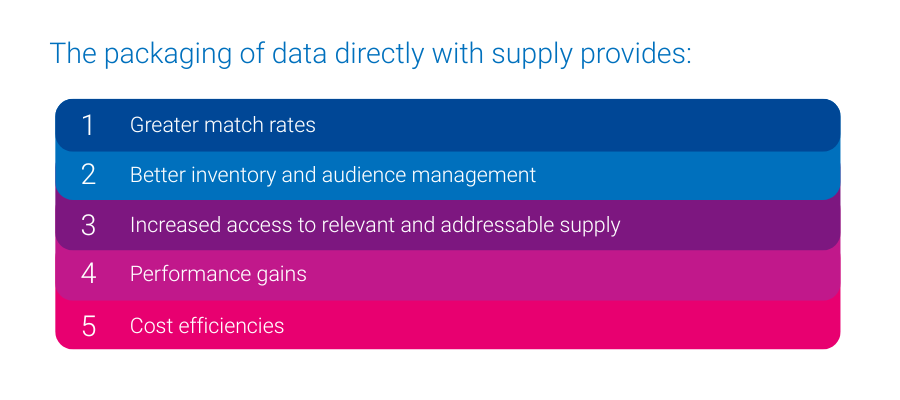
Audigent, a part of Experian, is excited to announce that curated audience and contextual inventory packages are now accessible on Google Display and Video 360 (DV360), delivered via Index Marketplaces. These premium deals offer industry-leading targeting solutions, combining high-quality data and inventory to enhance scale, value, and performance across connected TV (CTV), display, and online video (OLV).
The integration launches with over 250 ready-to-run deals covering various sectors, including some available for DV360 buyers for the first time, such as automotive, B2B, seasonal retail, sports fandom, travel, and weather, among others. Each deal combines exclusive audience data with premium inventory under a single DV360 deal ID. The supply-side activation lets you scale campaigns without cookies or device IDs, so results stay consistent even as traditional tracking disappears.
“We’re excited to expand Audigent’s curated, data-enriched packages in DV360 with Index Exchange. Putting Experian’s audiences and Audigent’s premium supply inside a single deal ID accelerates smarter decisions for marketers—letting brands activate, test, and see results right away.”
Chris Feo, Chief Business Officer, Experian
Why these packages stand out
Three reasons these packages drive results
- Signal-agnostic reach: Cookieless, device-less targeting preserves scale today and tomorrow.
- Instant activation: Traders simply add the pre-curated deal ID to a DV360 line item and go live in seconds.
- Built-in quality assurance: Exclusive audience data is paired with hand-vetted inventory, so you start closer to KPIs from day one.

Direct-to-source media buying that pays off
By packaging curated, data-enriched deals directly atop Index Exchange, via the Index Marketplaces platform, Audigent eliminates extra hops and integrates premium partner data into a single price, with no additional data management platform (DMP) fees. That means higher match rates, simplified audience management, and a cleaner, greener path that concentrates spend on top-tier publishers. Paired with Index Exchange’s omnichannel reach, brands see stronger performance and lower waste, no trade-offs required.
“Our goal with Index Marketplaces is to streamline access to premium supply, high-quality data, and measurable outcomes. Hosting Audigent’s ready-to-run deals on Index lets DV360 buyers tap addressable inventory curated for scale, sustainability, and speed – no extra steps, just better results.”
Paul Zovighian, Vice President of Marketplaces, Index Exchange
Real-world use cases
Audigent’s deep data collaboration bench isn’t window dressing; it’s baked into every package. Deterministic signals from Experian and fellow data leaders come pre-loaded, so you tap high-intent, high-match audiences the instant you activate a deal ID.
“This collaboration integrates The Weather Company’s industry‑leading weather forecast data into DV360, the world’s largest buying platform, enabling real‑time relevance through curated deals. Experian contributes deep expertise in consumer audiences, The Weather Company delivers unmatched precision in timing and location, and Index Exchange adds efficiency and transparency – together creating a streamlined, turnkey solution for activation.”
Dave Olesnevich, VP of Data and Ad Product, The Weather Company
Ready to activate?
Search Audigent in DV360’s Marketplace, select the Audigent package that fits your KPIs, and add the deal ID to your line item.
Prefer a custom build? Reach out to us at partnershipsales@experian to curate a package tailored to your campaign goals. The quickest path to performance is just one deal ID away.
Contact us now
Latest posts

Third-party cookies have been a crucial component in people-based advertising and digital identity. With Google's recent announcement of delaying third-party cookie deprecation to 2024, the industry has more time to rethink how to effectively identify and communicate with consumers when the time comes. Preparing for cookie deprecation Solving for the post-cookie world is mission critical, particularly as consumer expectation for a relevant digital experience is heightened. We’ve seen a number of industry participants, including brands, publishers, data providers and technology platforms, work around the clock to find an alternative to third-party cookies—one that amasses the same scale and reach but also maintains consumer privacy. In fact, industry insights echo that sentiment. According to a white paper from Winterberry Group, Collaborative Data Solutions: The Evolution of Identity in a Privacy-First, Post-Cookie World, sponsored in part by Experian, one of the most frequently heard comments was the urgency for the industry to develop post-cookie, privacy compliant solutions that work in a more integrated manner. And if there was one overarching position regarding the research into the future of identity, it’s that collaboration is key. Participants in the white paper expressed that with the elimination of third-party cookies, there will be a surge in collaborative solutions across and within companies to accommodate changes in the digital marketplace. Collaborative data solutions must move beyond new post-cookie identity replacements and encompass more holistic approaches, including first-party data. First-party data sharing Currently, 64.3 percent of organizations in the US collaborate with other organizations to share first-party data for insights, activation, measurement or attribution, and 16.7 percent in the U.S. have plans to. Virtually all US companies surveyed were aware of the option to collaborate with other organizations and expressed openness to discussions around sharing first-party data. What is the solution to third-party cookie deprecation? The deprecation of third-party cookies is creating a shock in the marketing and advertising world because there has been an over-dependence on one type of identifier. Therefore, the solution to identify consumers across the digital ecosystem will not come from a single replacement for third-party cookies. Instead, it will rely on a combination of solutions, including collaborative data between organizations and implementation of proprietary first-party data strategies, as well as a framework that can connect all these touchpoints together. Experian can help you navigate the cookieless future Experian is focused on building a more effective advertising ecosystem that promotes the interoperability of digital touchpoints while enabling and fostering new innovations in a privacy forward way. Contact us today and get started with building connected identity in the ever-changing data landscape. To learn more, watch the recording of our webinar with The Vitamin Shoppe where we discuss identity and how you can drive more addressable audience strategies amidst diminishing data signals. Get in touch

As today’s digital landscape gets more and more complicated there are more ways for brands to connect with users and drive purchases and more ways for ad tech to target and measure those touch points. As in-person shopping picks up steam due to the re-normalization of society post-COVID 19; the connection between digital ads and in-person purchases needs to be made once again. With the rise of Connected TV throughout the pandemic there are even more digital opportunities to target a user. But how do you make sure that those brand engagements are captured and correctly attributed to offline purchases and conversions? The answer lies in a holistic identity resolution strategy. Cross-device identity resolution with The Tapad Graph connects the identifiers and devices of individuals within a household to each other; enabling targeting, frequency capping, extension, segmentation and measurement or attribution between devices; including Connected TV and hashed (privacy-protected) email addresses along with Cookies, Mobile Ad Ids and IP Address. Brands can join their first-party data to The Tapad Graph to execute strategies that connect online and offline data for pre, mid and post-campaign efficiencies. Let’s imagine a scenario in which an outdoor retail brand is targeting users watching specific content on a Connected TV device. Powered by identity resolution, they start with a general ad on CTV and continue targeting down individual paths with each user. When one of them converts in store and makes a purchase; the outdoor retailer can connect that action through location and in-store traffic data with the cross-device identity resolution used to execute the digital campaign. Now the actions of the user online and offline are resolved for more accurate measurement and attribution after the campaign ends. But it doesn’t stop there– the brand's CRM data can be reactivated for the next digital campaign and leveraged to capitalize on the most effective media mix for the user who made the purchase previously. These combined insights can be invaluable in shaping up future campaign strategies with geo-contextual ads, recommended additional products and personalization to help drive more conversions and purchases in-store or online. As in-person shopping picks back up and marketers are tasked once again with balancing online and in-store KPIs, the right identity resolution strategy can unlock necessary efficiencies for retailers, ad tech vendors and agencies tasked with supporting these initiatives. Get in touch

Experian Marketing Services and Data Quality President Genevieve Juillard recently sat down with Zach Rodgers, host of the AdExchanger Talks podcast to discuss the future of identity, the importance of data transparency and privacy, and our recent acquisition of Tapad. Genevieve focused on the opportunity for our industry to reimagine an advertising ecosystem that is resilient and adaptable; one that takes advantage of emerging data and prioritizes data transparency and consumer privacy. She also discussed the importance of advertising strategies that put consumers at the heart of every decision and give them more control over their data. Genevieve shared with AdExchanger that Experian’s acquisition of Tapad, a global leader in digital identity resolution, was a natural fit for our company. Tapad’s approach and role in the ecosystem is very much aligned with Experian’s, which is to develop solutions that are resilient to industry and consumer changes. The combination of our capabilities supports interoperability across all types of identifiers, both online and offline, and will position us to help our clients navigate the post-third-party cookie world. To learn more about Experian’s plans to support an effective advertising ecosystem that will evolve with our dynamic industry, listen to the full podcast Embracing ‘Healthy Fragmentation’ In Ad Tech, With Genevieve Juillard. Get in touch







